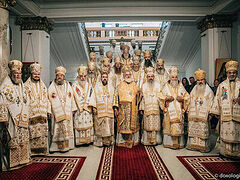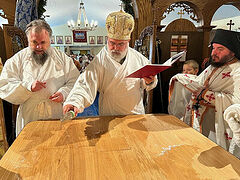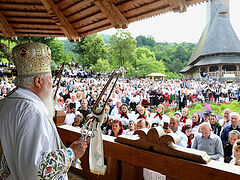Huși, Vaslui County, Romania, October 24, 2023
“Sunday, October 22, 2023 will remain as a milestone in the history of the Vovidenia Skete in Huși,” writes the Diocese of Huși.
This day, the diocese writes, signals the coming revival of the skete, “which has become a symbol of Huși.”
Protosinghel Fr. Cyprian (Aenea), entrusted with the reopening of the skete, celebrated the Divine Liturgy in a chapel erected near the ruins of the monastery church for the first time this weekend.
 Fr. Cyprian (Aenea) celebrated the Divine Liturgy in a chapel built near the ruins of the skete. Photo: basilica.ro
Fr. Cyprian (Aenea) celebrated the Divine Liturgy in a chapel built near the ruins of the skete. Photo: basilica.ro
Many faithful joined Fr. Cyprian, “bringing life and spirit to the place that will be reinvigorated on the map of Huși spirituality.”
The skete will be officially reopened on November 21 on its patronal feast of the Entrance of the Most Holy Theotokos Into the Temple.
***
The Church of Vovidenia Skete, which watches over the city of Huși, was built during the episcopate of Bishop Nifon (Criveanu) to serve the elderly home of the Huși Diocese located in that area. It was consecrated at the end of 1939 and, at that time, outside the diocesan cathedral in Huși, it was the only monastic settlement in Fălciu County (today the skete falls within the territory of Vaslui County).
However, the history of a monastic settlement in that location dates back much further, most likely to the 16th century. The ruins of an older skete could still be seen in the years before the foundation, by Bishop Nifon, of the new monastic establishment.
In January 1939, Fr. Anton Popescu penned a beautiful editorial in honor of the newly built church:
A new church is a new house of the Lord, a new place of worship, a new altar where the Lord and Savior Jesus Christ sacrifices Himself for us. It’s also a house for man. A house where men pray, tremble in soul, and stir their beings, where they bend their knees and humble their bodies. It is a house guarded by the Cross, where people place their confessions at the feet of the Lord and continually send Him streams of prayers. A new church is a new place for the purification of the soul. This is the church beneath the Coțoi Hill, near Huși. Heading south, you ascend towards this new altar, just as people used to climb the Mount of Beatitudes in ancient times. From there, from above, Christ the Savior proclaims the same simple and profound Beatitudes as He did 19 centuries ago. As you climb towards the church, you ascend with Jesus to the Mount of the Transfiguration. And if you have the soul of a Christian, imbued with the mystery of Christ’s sacrifice, you cannot help but change your life.
 Vovidenia Skete overlooking Huși. Photo: mapio.net
Vovidenia Skete overlooking Huși. Photo: mapio.net
As you ascend to the church on the hill, you ascend with the Lord Jesus upon the Golgotha of sacrifice. But up there, He will sacrifice Himself for those who will pray within the new walls, for the city at the foot of the hill from which He will henceforth watch over them, under the care of a faithful bishop. And He, the sinless One, will sacrifice Himself for the whole world. A new church for Huși is almost ready—the ninth altar where the Savior will dwell. Two craftsmen are busy with the painting. It will be completed soon. So, before long, a new bell will ring its call over Huși and its surroundings, calling the faithful to prayer and reminding them that it's time to turn their thoughts to the Lord God. A new church? The most beautiful deed of a man. Even more so of a bishop. And the new church is being erected by His Grace Bishop Nifon as a sign of his faith and as a gift—the greatest gift—to this city in which dozens of bishops and as many voivodes have resided. Look at it! It’s small, but it has room for God and your soul, dear Christian, for you to pray there. And thus, not far from the diocese, the new foundation rises and is the only monastic haven in the land of Fălciu. Come and worship there!
Several outlets write that the church and other skete buildings were damaged by landslides over the years, and Vremea Noua also mentions arson. It was repaired in 1971, but then an earthquake struck in 1977.
A historical account of the skete was compiled in 1998 by Archimandrite Mina (Dobzeu), who, after coming to Huși, periodically served in this small church and, after 1991, initiated the reestablishment of the monastic institution.
Follow OrthoChristian on Twitter, Vkontakte, Telegram, WhatsApp, MeWe, and Gab!






